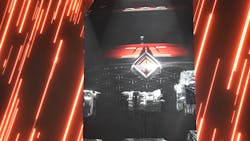In introducing the new S13 Integrated Powertrain, Navistar President and CEO Mathias Carlbaum duly lauded it as “the most efficient powertrain we’ve ever produced” and also as “a milestone on the journey” to zero-emission vehicles.
“We are not only here to launch a new product, but to mark a new chapter for International,” Carlbaum said.
I couldn’t see the crowd behind me from my place in press row for the launch event, but I suspect an arched eyebrow or two and certainly a collective sigh of relief from the longtime International dealers and customers on hand.
See also: Closer look: Navistar’s new powertrain advances emission control
For the record, this will be the last time I refer to Navistar’s troubles of a decade ago. For those more recent to the industry, that’s when the decision to stick with EGR technology to meet stricter emissions regulations—while the rest of the industry moved to SCR—nearly doomed the historic American brand and industrial icon. Sure, it made strategic sense to keep the emissions system simple compared to the Rube Goldberg contraption SCR was shaping up to be. Except SCR worked; “advanced” EGR did not.
So I wouldn’t be much of a journalist if I didn’t consider the significance of the Navistar event beyond the otherwise expected enthusiastic marketing pitch.
First, the basics: How exactly could Navistar, working closely with parent company Traton to develop a powertrain for the North American market, deliver such an improved system?
Essentially, that’s the advantage of starting from scratch.
The noteworthy distinction for the S13 is the aftertreatment technology has been a critical part of the integration strategy from the beginning. So, sure, for at least a decade, competitors have emphasized the advantages of manufacturing both the engine and the transmission, but Navistar/Traton is the first—and, so far, only—global truck OEM to develop an entirely new platform, as Michael Grahe, head of operations at Navistar, explained in an interview.
“Now, at least as I understand it, all the other heavy-duty engines out there were designed and developed before SCR. Then the emission regulations became stricter and stricter and everybody decided, hey, we have to put something on [the engine]—and the solution was SCR,” Grahe said. "So none of those engines was from a base engine developed with the combustion logic for an SCR application—this always came later.
“We had the advantage of this clean-slate approach; we knew from the beginning this is going to be an SCR engine. We also knew what the transmission would be because we were designing the aftertreatment. And this is why we could reduce particulate matter and the soot and why we don't need active regen.”
See also: Navistar's new truck includes OEM's final internal combustion engine
Makes perfect sense. Now the fun part: How can anyone not appreciate the irony of this coming from Navistar? I happened to sit with Darren Gosbee, vice president of engineering at Navistar, at dinner following the big launch and he didn’t even blink when I mentioned this.
“There is irony in so many places,” Gosbee said, and he outlined his time with the company. He came to Navistar almost 15 years ago as director of hybrid vehicle strategy and execution and soon became director of engineering for Navistar’s electric vehicle program. There is, however, a downside to being ahead of the times.
“There was no market; there was no demand,” he noted.
For those doing the math, this was also about the time that Navistar had—to use Gosbee’s term—“emissions issues.” And so the guy brought in to develop hybrid and EV powertrains suddenly was working on the “massive transition” from the failed advanced EGR strategy to implementing SCR technology.
“So the irony just keeps coming,” Gosbee said. “And now here we are, come full circle.”
Needless to say, after several years of playing catch-up, the merger with Traton—the level of investment and collaboration in product development—has given Gosbee a lot to be optimistic about.
“I’m not going to be giving too much away, but we have a very aggressive product plan—a lot of new technologies—and this engine is the first of them; it's designed to integrate into the future vehicle with minimal work. So the way that we partition functions, and the way that we've designed things, this engine and powertrain are ready to go into the next wave of technology changes that are coming. Pretty exciting stuff.”
And Gosbee also gets the last word on the “new chapter” for Navistar and International.
“We are what we are now and we’re better for it,” he said.
About the Author
Kevin Jones
Editor
Kevin has served as editor-in-chief of Trailer/Body Builders magazine since 2017—just the third editor in the magazine’s 60 years. He is also editorial director for Endeavor Business Media’s Commercial Vehicle group, which includes FleetOwner, Bulk Transporter, Refrigerated Transporter, American Trucker, and Fleet Maintenance magazines and websites.
Working from Beaufort, S.C., Kevin has covered trucking and manufacturing for nearly 20 years. His writing and commentary about the trucking industry and, previously, business and government, has been recognized with numerous state, regional, and national journalism awards.

